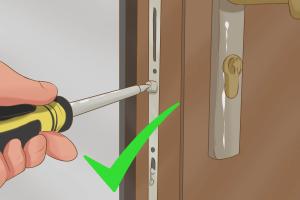Ultimate Guide to Changing a UPVC Door Lock: Step-by-Step Instructions

-
Quick Links:
- 1. Introduction
- 2. Understanding UPVC Doors and Locks
- 3. Why Change a UPVC Door Lock?
- 4. Tools Required
- 5. Step-by-Step Guide to Changing a UPVC Door Lock
- 6. Common Issues and Solutions
- 7. Expert Insights and Tips
- 8. Case Studies
- 9. FAQs
- 10. Conclusion
1. Introduction
Changing a UPVC door lock might seem daunting, but with the right tools and guidance, it can be a straightforward DIY task. This guide will walk you through the entire process, ensuring you understand each step and the importance of maintaining your home security. Whether you've lost your keys, experienced a break-in, or are simply upgrading for better security, this comprehensive guide has you covered.
2. Understanding UPVC Doors and Locks
UPVC (Unplasticized Polyvinyl Chloride) doors are popular for their durability and low maintenance. They are often equipped with multi-point locking systems that offer superior security compared to traditional locks.
- Benefits of UPVC Doors: Energy efficiency, weather resistance, and a variety of styles.
- Types of UPVC Locks: Single cylinder, double cylinder, and multi-point locks.
3. Why Change a UPVC Door Lock?
There are several reasons you may want to change your UPVC door lock:
- Lost Keys: If you've misplaced your keys, it’s crucial to change the lock to prevent unauthorized access.
- Wear and Tear: Locks can become worn over time, compromising security.
- Upgrading Security: New locks may offer better security features, such as anti-drill or anti-pick mechanisms.
4. Tools Required
Before starting the lock change, gather the following tools:
- Screwdriver (flathead and Phillips)
- Allen key (if required)
- Tape measure
- Replacement lock
- Lubricant (optional)
5. Step-by-Step Guide to Changing a UPVC Door Lock
Follow these detailed steps to successfully change your UPVC door lock:
Step 1: Remove the Door Handle
Begin by removing the door handle to access the lock mechanism. Use a screwdriver to unscrew the screws securing the handle.
Step 2: Remove the Lock Cylinder
Once the handle is off, you can see the lock cylinder. Use the Allen key to remove it. Pull the lock cylinder straight out of the door.
Step 3: Measure the New Lock
Before installing a new lock, measure the old one to ensure compatibility. Most UPVC locks have standard sizes, but it's best to verify.
Step 4: Install the New Lock
Insert the new lock cylinder into the door, aligning it with the screw holes. Secure it in place with screws.
Step 5: Reattach the Door Handle
Once the lock is secured, put the door handle back in place and screw it tightly.
Step 6: Test the Lock
Before finishing, test the lock by turning the key multiple times to ensure it operates smoothly.
6. Common Issues and Solutions
While changing a UPVC door lock is generally straightforward, you might encounter some common issues:
- Lock Misalignment: If the lock doesn't align properly, check the installation and ensure everything is secured correctly.
- Key Won't Turn: This could be due to debris or misalignment; lubricate the lock if necessary.
7. Expert Insights and Tips
Here are some expert tips to ensure your lock change is successful:
- Always choose high-quality locks from reputable manufacturers.
- Consider a lock with a higher security rating for enhanced protection.
- Keep your locks maintained; regular lubrication can prevent issues.
8. Case Studies
To illustrate the importance of regular lock maintenance, consider the following examples:
- Case Study 1: A homeowner lost their keys and faced a burglary because they had not changed their lock.
- Case Study 2: An individual upgraded to a smart lock, resulting in increased home security and convenience.
9. FAQs
FAQs
1. How often should I change my UPVC door lock?
It's recommended to change your lock every 5-7 years or immediately if you lose your keys.
2. Can I change a UPVC door lock myself?
Yes, with the right tools and instructions, changing a UPVC door lock is a feasible DIY task.
3. What type of lock is best for UPVC doors?
Multi-point locks are generally considered the best for UPVC doors due to their enhanced security features.
4. Are all UPVC door locks the same size?
No, while many are standard sizes, it's essential to measure your existing lock before purchasing a replacement.
5. Do I need a professional locksmith to change my lock?
Not necessarily; many homeowners can successfully change their locks with the right guidance.
6. What should I do if my new lock doesn't fit?
Double-check the measurements and ensure you're using a compatible lock. You may need to consult a locksmith if issues persist.
7. How can I improve the security of my UPVC door?
Consider upgrading to a higher security lock, adding a security camera, or installing a door chain.
8. Is it necessary to lubricate my lock?
Yes, regular lubrication can help maintain the lock's functionality and prevent sticking.
9. Can I replace just the lock cylinder?
Yes, if the rest of the lock mechanism is in good condition, you can replace just the cylinder.
10. What are the signs that my lock needs to be replaced?
Signs include difficulty turning the key, visible wear, and if the lock feels loose or unstable.
10. Conclusion
Changing a UPVC door lock is an important maintenance task that can enhance your home security. By following this guide, you can confidently tackle the job yourself, ensuring that your home remains safe and secure. Remember to consider the quality of locks and regularly maintain them for optimal performance.